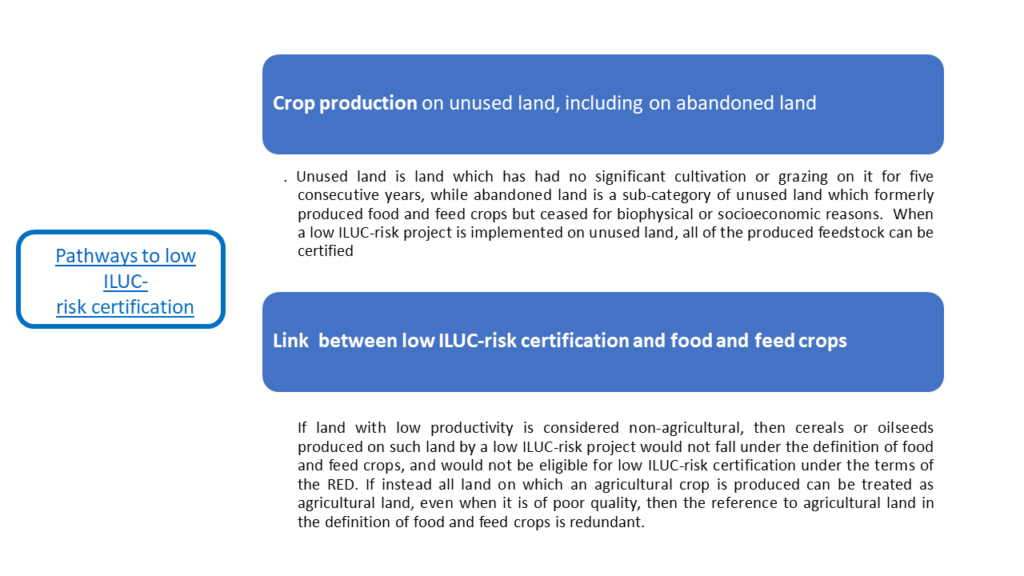Low ILUC definition
The concept for low ILUC-risk biofuel production is that by developing new systems to expand agricultural production, it is possible to deliver biofuel feedstock without impacting existing food and feed markets. Low ILUC-risk production systems fall into three main categories: growing a crop on land that is unused (for instance that has been abandoned or become degraded); increasing production of an existing crop; or adding an additional intermediate crop (for instance a productive winter cover crop or an intercrop) to an existing system.
Low ILUC-risk crops are crops grown in a way that avoids displacement of other land uses. They must go beyond the crop outputs that would have been produced if no low ILUC-risk project was implemented, meaning that the feedstock is grown purely to meet demand from the biofuels market. In the language of the RED II, feedstock from a given farm may be certified as low ILUC-risk if it is “additional feedstock obtained through additionality measures” In some cases, this means a whole extra crop; in others, an increase in productivity for an existing crop.
In the RED II, the main role given to low ILUC-risk certification is as a basis to exempt batches of fuel from the limitations placed on food and feed crops designated as high ILUC-risk. This emphasis on food and feed crops is reflected in the regulatory definitions. For example, low ILUC-risk biofuels are defined as:
“fuels, the feedstock of which was produced within schemes which avoid displacement effects of food and feed-crop based biofuels, bioliquids and biomass fuels through improved agricultural practices”;
The low ILUC-risk concept seeks to promote the production of biofuel feedstocks in a way that does not interfere with existing food and feed markets. The feedstock production must be ‘additional’ to be certified as low ILUC-risk, and must result from implementation of a farm-level ‘additionality measure’, defined as:
“any improvement of agricultural practices leading, in a sustainable manner, to an increase in yields of food and feed crops on land that is already used for the cultivation of food and feed crops; and any action that enables the cultivation of food and feed crops on unused land, including abandoned land”
Low ILUC-risk crops are crops grown in a way that avoids displacement of other land uses. They must go beyond the crop outputs that would have been produced if no low ILUC-risk project was implemented, meaning that the feedstock is grown purely to meet demand from the biofuels market. In the language of the RED II, feedstock from a given farm may be certified as low ILUC-risk if it is “additional feedstock obtained through additionality measures” In some cases, this means a whole extra crop; in others, an increase in productivity for an existing crop.
In the RED II, the main role given to low ILUC-risk certification is as a basis to exempt batches of fuel from the limitations placed on food and feed crops designated as high ILUC-risk. This emphasis on food and feed crops is reflected in the regulatory definitions. For example, low ILUC-risk biofuels are defined as:
“fuels, the feedstock of which was produced within schemes which avoid displacement effects of food and feed-crop based biofuels, bioliquids and biomass fuels through improved agricultural practices”;
The low ILUC-risk concept seeks to promote the production of biofuel feedstocks in a way that does not interfere with existing food and feed markets. The feedstock production must be ‘additional’ to be certified as low ILUC-risk, and must result from implementation of a farm-level ‘additionality measure’, defined as:
“any improvement of agricultural practices leading, in a sustainable manner, to an increase in yields of food and feed crops on land that is already used for the cultivation of food and feed crops; and any action that enables the cultivation of food and feed crops on unused land, including abandoned land”


A list of eligible additionality measures for yield increase is provided in a Commission Implementing Regulation. This list identifies four categories of additionality measures: mechanisation; multi-cropping; management; and replanting (for perennial crops). These have a proven track record of improving on-farm productivity, and can be applied by an economic operator with the provision that they do not compromise long-term sustainability. BIKE has clear recommendations on additionality measures.
References/links in BIKE website and others:
- https://www.bike-biofuels.eu/wp-content/uploads/2023/02/BIKE_WP5_BriefingNote_1-Low-ILUC-Risk-Policy-Overview.pdf
- https://www.bike-biofuels.eu/wp-content/uploads/2022/12/BIKE_WP5_BriefingNote_2-Policy-Definitions.pdf
- https://www.bike-biofuels.eu/wp-content/uploads/2023/02/BIKE_WP5_BriefingNote_4-Additionally-Measures.pdf
- https://eur-lex.europa.eu/legal-content/EN/TXT/HTML/?uri=CELEX:52019DC0142&from=EN
- https://www.bike-biofuels.eu/wp-content/uploads/2023/02/BIKE_WP5_BriefingNote_4-Additionally-Measures.pdf
